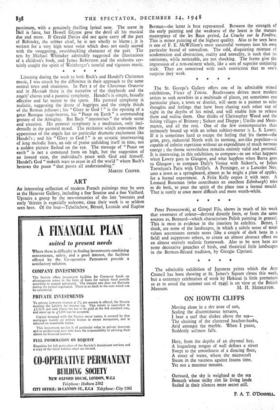ART
AN Interesting collection of modem French paintings may be seen at the Hanover Gallery, including a fine Soutine and a fine Vuillard. Upstairs a group by the neo-romantics of the late 'twenties and early 'thirties is especially welcome, since their work is so seldom seen here. Of the four—Tchelitchew, Berard, Leonide and Eugene Berman—the latter is best represented. Between the strength of the early painting and the weakness' of the latest is the mature masterpiece of the les Baux period, La Cruche sur la Fenetre. This is minor painting of the highest quality. Also to be, seen here is one of F. E. McWilliam's most successful ventures into his own particular brand of surrealism. The odd, disquieting mixture of academicism and abstraction, reality and unreality, is such that its omissions, while noticeable, are not shocking. The forms give the impression of a non-existent whole, like a sort of superior conjuring trick. They are conceived with such conviction that to one's surprise they work.
The St. George's Gallery offers one of its admirable mixed exhibitions, Views of Towns. Restlessness drives most modern artists to seek novelties in a multitude of places, yet sometimes one particular place, a town or district, will seem to a painter to echo thoughts and feelings that have been chasing each other out of sight in the depths of his mind, and will enable him to release them and realise them. One thinks of Christopher Wood and the fishing villages of Brittany ; Sickert and Dieppe ; Utrillo and Mont- martre, and all the rest. One of the few contemporaries thus intimately bound up with an urban subject-matter is L. S. Lowry. If it is sometimes hard to escape the feeling that his theme—the grim, grey, industrial North with its teeming, ant-like populace—is capable of infinite repetition without an expenditure of much nervous energy ; the theme nevertheless remains entirely valid and personal. It is interesting, in this exhibition, to compare—to see what happens when Lowry goes to Glasgow, and what happens when Burra goes to Glasgow ; to compare Dufy's Venice with Sickert's, or Julian Trevelyan's Paris with Utrillo's. A Feininger, or a Lancelot Ney, uses a town as a springboard, almost as he might a plate of apples, for a formal experiment. A Felix Kelly copies it with taste. A Leonard Rosoman (who contributes an excellent Edinburgh) tries to do both, to pour the spirit of the place into a formal mould. That is surely at once more difficult and more worth-while.
Peter Potworowski, at Gimpel Fils, shows in much of his work that sweetness of colour—derived directly from, or from the same sources as, Bonnard—which characterises Polish painting in general. This is most in evidence in the interiors he exhibits. Better, I think, are some of the landscapes, in which a subtle sense of tonal values accentuates certain notes (like a couple of dark hens in a field) and suppresses others, to create an almost abstract effect on an almost entirely realistic framework. Also to be seen here are some decorative gouaches of birds, and theatrical little landscapes in the Berman-Berard tradition, by Giorgio Cipriani.
The admirable exhibition of Japanese prints which the Arts Council has been showing at St. James's Square closes this week, but a centenary celebration of work by Hokusai (a little premature, so as to avoid the summer sun of 1949) is on view at the British


































 Previous page
Previous page